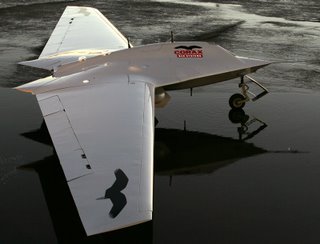Occasional Commentaries on Global Peace and Justice and Human Rights Issues from West Wales
Friday, August 18, 2006
Military Transformation and Local Politics
Last night I chaired the public BEPJ meeting on the Middle East held in Carmarthen. The speakers at the meeting, Anne Dickinson, Maggie Nicols and Rhodri Glyn Thomas AM, spoke about the current situation in Palestine, the war and ceasefire in Lebanon and also the non violent direct action in Parliament Square by Brian Law. However it was when we got into the question and answer session that a lively debate ensued. A major issue was raised about whether the National Assembly For Wales has any powers to intervene in issues such as low flying military aircraft and other activities in West Wales. Rhodri Glyn Thomas AM (Plaid Cymru), who had delivered an excellent speech on Plaid Cymru's Middle East policy and also on the current position in Lebanon and Palestine, said that the Assembly were not involved in defence issues and had no realpowers to influence the Government on these issues apart from sending letters of protest etc. It was at this point that I raised the issue of the ASTRAEA project and NAFW commitment to invest £3 million in the Aberporth based project with him. Rhodri said that whilst he was aware of some of the developments in Aberporth he did not know about the commitment to fund the ASTRAEA project and was sure this had not been debated on the floor of the assembly. This project is extremely worrying for we ordinary mortals living in West Wales as most of us only get to hear about the WDA trumpetings of new jobs and economic development opportunities but nothing about what is actually being planned at Parc Aberporth. To put it simply, what kind of jobs are they going to be and what will the products arising out of this industrial development be used for? There was lively discussion about the way in which many of the areas where US, UK and Israeli forces are in action appear to be testing grounds for much of the new technology that is being developed by Armaments companies and also govt agencies around the world. It was generally accepted by the meeting that at the very least people have a right to know what their elected representatives are going to spend their taxes on BEFORE they spend them. It was suggested that a demonstration on the issue of UCAV research and development at Parc Aberporth and at the QinetiQ site in Aberporth be organised in the near future. This was a positive Non Violent Direct Action (NVDA) suggestion and one which will need some co-ordination between anti-war groups and others across Wales. I shall also be writing to Rhodri and asking him to pose some key questions on the way in which the National Assembly appears so keen to get into bed with the following partners:- EADS ( European Aeronautic Defence and Space Company), FRL (Flight Refueling Limited), THALES , BAE Systems , all of which are amongst the major Armaments developers in the world. It is time that Andrew Davies AM, Welsh Assembly Government Minister for Enterprise Innovation and Networks, began to understand that Wales is a fledging democracy and that the people of Wales do not want to be larded up with spin in the usual smoke and mirrors approach of Westminster style government. We demand better and we want to know that our industry in Wales is being used for other purposes than being part of the US led world domination inspired military transformation strategy that Bush and Blair have so completely bought into. So, what is this strategy and where does it come from? more info in next posting....
Thursday, August 17, 2006
UAVs, UCAVs and AI (continued)
This post contains text that is a direct lift from the QinetiQ web site and shows perfectly clearly what the the future operational capability at Parc Aberporth is intended to be. The introduction of Artificial Intelligence (AI) into the world of Unmanned Aerial Vehicles especially Unmanned Combat Aerial Vehicles is extremely alarming but not unexpected and links in very clearly with the new military transformation ideology coming out of the Pentagon over recent years. I will comment further on this in my next post, however it is important that people begin to understand what the former MOD base at Aberporth is being used for and also how National Assembly For Wales funds are being used.
So there we are then, QinetiQ make no bones about the fact that they are going to be linking in with the UCAV programme for the Ministry of Defence and will be linking in with BAE who are not only joint partners in the ASTREA project but are also going to have offices in the Parc Aberporth complex. Those people who are in favour of the civil aviation authority airport planned for Aberporth might think twice about Arms Dealers and international Weaponry Experts flying in and out of West Wales. This is just the start of this story as there is a lot more to come, see you soon...
Artificial intelligence and unmanned missions.
The demand for unmanned aerial and combat aerial vehicles (UAV/UCAV) is rising sharply. It's a response to the increasing danger from highly mobile threats, and the need to rapidly engage high-value targets of opportunity, especially deep in unfriendly territory and dangerous environments.The context, issues and actionAs their use rises, UAV/UCAV will come under widely dispersed controllers. These individuals will have to keep track of all single and multiple missions and stay up-to-date with every task and mission constraint, often over long periods.Missions like these will probably exceed available UAV personnel and communications bandwidth, creating a need for flexible or autonomous UAV/UCAV mission management processes.Our solutionTo tackle this problem two teams at QinetiQ began a research programme for the MoD in April 2001, aiming to enhance military capabilities for the medium-term 2005-10. They are exploring emerging artificial intelligence (Al) technologies that offer promising support for flexible and autonomous mission management, including planning, monitoring and control. The focus is on how emerging Al technologies can:assist the Command and Control processreduce the burden on UAV operatorssupport a more dynamic re-planning process.Some non-technical barriers - such as common or shared terms for interoperability, and security classifications - still hamper military field implementation. But our research clearly shows that we have now overcome many of the technical barriers. Although Al planning technology has been around for the past decade, it was mainly an academic study. Now, though, there are military systems that can fully exploit the technology, as part of complex and distributed C2 systems supporting high-tempo military missions.With a computer-aided planner we can now link human and Al elements, and the distributed working and restricted bandwidth operations. So that the plan can pass from user to user easily and quickly.Mission/collection planningAdvances in knowledge-based planning techniques and constraint-based scheduling technologies mean that they can now be applied to complex military logistics problems. With techniques now mature enough to support mission/collection planning tasks, the key is to use the explicit plan description languages that record planning decisions and capture the plan rationale.Mission monitoring and controlThe strides forward in commercial work-flow and group-working techniques mean that we can apply these techniques to mission monitoring and control - especially when they're integrated with distributed database systems.Artificial intelligence and unmanned missions The demand for unmanned aerial and combat aerial vehicles (UAV/UCAV) is rising sharply. It's a response to the increasing danger from highly mobile threats, and the need to rapidly engage high-value targets of opportunity, especially deep in unfriendly territory and dangerous environments.The context, issues and actionAs their use rises, UAV/UCAV will come under widely dispersed controllers. These individuals will have to keep track of all single and multiple missions and stay up-to-date with every task and mission constraint, often over long periods.Missions like these will probably exceed available UAV personnel and communications bandwidth, creating a need for flexible or autonomous UAV/UCAV mission management processes.Our solutionTo tackle this problem two teams at QinetiQ began a research programme for the MoD in April 2001, aiming to enhance military capabilities for the medium-term 2005-10. They are exploring emerging artificial intelligence (Al) technologies that offer promising support for flexible and autonomous mission management, including planning, monitoring and control. The focus is on how emerging Al technologies can:assist the Command and Control processreduce the burden on UAV operatorssupport a more dynamic re-planning process.Some non-technical barriers - such as common or shared terms for interoperability, and security classifications - still hamper military field implementation. But our research clearly shows that we have now overcome many of the technical barriers. Although Al planning technology has been around for the past decade, it was mainly an academic study. Now, though, there are military systems that can fully exploit the technology, as part of complex and distributed C2 systems supporting high-tempo military missions.With a computer-aided planner we can now link human and Al elements, and the distributed working and restricted bandwidth operations. So that the plan can pass from user to user easily and quickly.Mission/collection planningAdvances in knowledge-based planning techniques and constraint-based scheduling technologies mean that they can now be applied to complex military logistics problems. With techniques now mature enough to support mission/collection planning tasks, the key is to use the explicit plan description languages that record planning decisions and capture the plan rationale.Mission monitoring and controlThe strides forward in commercial work-flow and group-working techniques mean that we can apply these techniques to mission monitoring and control - especially when they're integrated with distributed database systems.
Other emerging technologiesPossibilities here include:procedural reasoning systems3D visualisation techniques including stereo and virtual reality headsetssimulated annealing and genetic algorithmsagent-based technologies for autonomous search and retrieval of past mission plans.
Energetic Qinetiq
UK research and technology house Qinetiq will use this year’s Farnborough air show to highlight its recent achievements in the unmanned air vehicle sector, which include successful risk-reduction trials of its lightweight Zephyr high-altitude, long-endurance (HALE) platform, expanded support for the ParcAberporth UAV centre of excellence and involvement in the Astraea airspace integration initiative.
Qinetiq will also exhibit a model of its latest Zephyr variant in the same configuration as the two air vehicles that completed successful proving flights at the White Sands missile test range in New Mexico last December. Dubbed air vehicles 5.1 and 5.2, they logged flights lasting 4.5h and 6h respectively and reached an altitude of 27,000ft (8,230m). However, the company believes a self-sustaining development of the Zephyr could extend mission endurance to around three months, with the aircraft operating at altitudes around 60,000ft – above the influence of the jetstream, adverse weather and commercial air traffic. The plan is for a Zephyr to fly using solar power during daylight hours while also storing sufficient energy in its rechargeable battery to power it through the night without falling below 50,000ft. While a rechargeable battery is still in development and has yet to undergo flight testing, the platform’s current solar arrays are capable of generating around 1kW despite an efficiency rating of less than 10%, says Qinetiq’s Zephyr business development director Paul Dave
Solar array
During the 2005 test flights, two sub-30kg (66lb) UAVs were flown, one using battery power alone and the other, which completed the longer sortie, drawing power from both a battery and the solar arrays on the aircraft’s 12m-span wing. Constructed using carbonfibre and a Mylar coating, and with removable fuselage and tail sections, the twin electric-motor-powered Zephyr could be used to conduct persistent surveillance, maintaining around 12kt (22km/h) and using GPS waypoint navigation to remain on-station. The air vehicle currently needs to sustain an angle of attack of around 6° during flight.
Although its lightweight structure and slow speed will restrict the air vehicle’s payload, Davey says its affordability and ease of operation are important characteristics for its future business prospects. “We will try to do one or two jobs very credibly,” he says, citing surveillance and communications relay tasks as possible contenders. The Zephyr system is not designed to compete with satellites, but could be used in combination with low-cost spacecraft such as the Qinetiq-designed TopSat.
A 40%-scale model of the Zephyr 5 vehicle was flown at lower levels in advance of the US trials to replicate the performance characteristics of its larger stable-mates at altitude. In the recent trials, the two air vehicles were hand-launched by three people, completed their sorties and landed without suffering damage despite their lack of an undercarriage or the use of a runway. The vehicles required no maintenance or logistics support following the flights, only visual inspection.
Night flights
Future flight trials are expected to include an overnight mission, for which the Zephyr’s solar array will have to store enough energy to keep the vehicle airborne through the hours of darkness. Funded using a mixture of company money and allocations from the UK Ministry of Defence, previous tests have included flights at the Woomera test range in South Australia. The MoD has shown some interest in the design for military applications, believed to include persistent reconnaissance and communications relay duties. Although 2005 test flights involved an unmanned system using its own automated flight-control software, the flight still required input from a pilot, navigator and flight engineer for qualification purposes, says Zephyr designer Chris Kelleher.
Qinetiq has so far manufactured between seven and nine Zephyrs across several variants, with the latest featuring a removable payload pod that can be screwed on to the aircraft’s nose to carry a lightweight electro-optical sensor or communication relay payload. The Zephyr was initially intended to form part of the Qinetiq 1 manned balloon altitude record attempt, with a tethered version of the UAV expected to achieve an altitude of 132,000ft. However, although production processes have improved over the life of the programme, Davey says: “We’re always looking to shave off another 10g [0.35oz] here or there.” The current air vehicle is capable of withstanding a gust loading of 5g, Qinetiq says.
Qinetiq is to provide support to UAV operations at Parc Aberporth in Wales
A civil version of the Zephyr, dubbed Mercator, has been built and is awaiting delivery to Belgium’s Flemish Institute for Technical Research but the project has been delayed while the Belgian authorities strive to come up with a means of certificating the experimental aircraft for HALE missions in Belgian airspace. The Mercator design, to be used as part of a remote-sensing project, closely resembles the Zephyr 5 but has an increased wing span of 16m. Qinetiq intends to ship the Mercator air vehicle to its Belgian arm Verhaert soon, ahead of delivery to its customer, which intends to conduct an initial 72h proving flight with the vehicle.
Davey sees a bright future for unmanned platforms such as the Zephyr and Mercator, which could be deployed in response to natural disasters. “If you have a disaster area you could put half a dozen Mercators up at 60,000ft and provide a basic rebroadcast capability,” he says. From that altitude, the UAV would be able to see 400km (215nm) in any direction, he adds. Qinetiq believes its HALE design could also be equipped with lightweight sensors in its wing to further boost its operational capabilities.
Observer cleared
Qinetiq’s evaluation work with UAVs is not restricted to the Zephyr series of air vehicles. The company has recently secured clearance to place its Observer demonstrator air vehicle back on the UK military register to support future trials and sensor integration. The UK MoD earlier this year asked Qinetiq to contribute a UAV system to support a Combined Qualified Weapons Instructor (CQWI) course at RAF Leuchars in Scotland, but bad weather during a May trials period prevented the Observer platform from participating in the manoeuvres, which also included around 50 manned strike and reconnaissance aircraft.
The Observer UAV is optimised for single operator control
The UK’s Air Warfare Centre has invited UAV manufacturers to supply systems to support such operations in the future, but is dependent on industry covering their own participation costs. Qinetiq says the Observer could take part in the next CQWI course in November, but weather conditions could again delay its participation in the exercise until next year. The company now has three air vehicles available: two equipped with electro-optical payloads and the other carrying an infrared sensor.
Nigel Mills, Qinetiq’s technical director – air, says military users continue to take the lead in the UAV sector, but their activities are primarily conducted through the use of test ranges and special permits to fly, or under combat conditions. With the commercial sector seemingly more reluctant to embrace unmanned aviation, he says: “The key issue to justify investment is the market.” Mills believes the UK’s initially three-year Astraea initiative is a key advance, and highlights his firm’s involvement in the scheme through technical area, including autonomy and the development of lightweight sensors.
Qinetiq’s previous work on autonomous systems is expected to continue into involvement in a new unmanned combat air vehicle (UCAV) technology demonstration programme to be headed by BAE Systems and now awaiting programme launch by the MoD. Mills believes Qinetiq’s work on passive millimetre-wave sensors capable of seeing through clouds – and into communications relays, miniature synthetic-aperture radars and lightweight electro-optical devices – could all lead to lucrative business in a future, expanded UAV sector.
BAE first flew a UCAV demonstrator, dubbed Raven, in late 2003. The low observable design is part of the company's wider work into UCAV technology for the British Defense Ministry.Two Raven carbon-fiber composite airframes have been built and flown. Test flights of the jet-powered UCAV demonstrator were carried out in Australia at the Woomera Range.British Defense Ministry interest in UCAV technology first emerged as part of its Future Offensive Air System (FOAS) program. The effort was intended to identify capabilities to fulfill the deep strike role now provided by the Royal Air Force's Tornado GR4. FOAS has since been succeeded by the Strategic Unmanned Aerial Vehicle (Experiment) (SUAVE) -- which Raven feeds into.
Precision landing systems – such as that already demonstrated using the company’s VAAC Harrier trials aircraft that is now supporting the development of flight-control laws for Lockheed Martin’s F-35B Joint Strike Fighter – are also applicable for use by UAVs, he says.
Qinetiq last month entered a partnership agreement with West Wales airport – home to the ParcAberporth development – to provide technical and support services to UAV operators at the site. To allow users to benefit from the experience of earlier trial and certification activities, the West Wales UAV Centre will charge from just “tens of pounds” to use its expertise, says Andrew Chadwick, Qinetiq’s business development manager for UAV services. Work to be offered by the new venture includes “the development of safety cases, system design advice and flying supervision”, the company says. A recent example saw a demonstration of the NitroHawk unmanned helicopter to police officials.
The new centre’s operators hope to expand such activities by securing a permanent sector of airspace around the site for UAV trials. The facility already has a temporary restricted area within 8km (5 miles) of the airport, but centre officials have asked the UK Civil Aviation Authority to make the segregation permanent. With the West Wales airport site and Qinetiq’s neighbouring Aberporth test range likely to play important parts in the later stages of the Astraea project, the elimination of the current three-month approvals process to fly unmanned aircraft from ParcAberporth will ease the process of acquiring permission to fly UAVs in non-segregated airspace on a routine basis. The joint application is expected to be approved by year-end, says Chadwick.
In an intriguing development, Qinetiq has also revealed that it plans to return its XRAE-1 unmanned aircraft to flight later this year after a gap of around a decade. In addition to its Observer demonstrator, the legacy UAV could serve as a testbed for new payloads, the company says. The XRAE design has a 2m wingspan, weighs around 20kg and is being eyed as a potential platform for civil test applications. Meanwhile, the company intends to use its Observer airframes as “sensor trucks” to assist in the development of military operations. However, repeating Mills’s concerns over the slow pace of growth in the commercial UAV business, Chadwick notes: “There is a risk in this – we are trusting a market that doesn’t exist yet.” However, he believes demand for UAVs will grow such that “the market will push the regulators”.
With an eye to future production, Qinetiq believes a strong market exists for a system such as the Zephyr and the commercial Mercator. With BAE likely to lead efforts to produce a UCAV and, potentially, stealthy unmanned surveillance aircraft for the UK armed forces over the decades to come, Qinetiq is also eyeing a potential market niche in the less-than-20kg product range, the company says.
In addition to its certification clearance work now taking place at ParcAberporth, Qinetiq is expanding its efforts to train current and future UAV operators. Focusing on trials and evaluation work, the first unmanned systems course to be managed by its Empire Test Pilots’ School at Boscombe Down in Wiltshire concluded recently, having involved 14 delegates from the UK MoD or from within the company organisation. The course involved the simulated use of an Observer air vehicle and an opportunity to witness live operations of the British Army’s Phoenix battlefield UAV system.
So there we are then, QinetiQ make no bones about the fact that they are going to be linking in with the UCAV programme for the Ministry of Defence and will be linking in with BAE who are not only joint partners in the ASTREA project but are also going to have offices in the Parc Aberporth complex. Those people who are in favour of the civil aviation authority airport planned for Aberporth might think twice about Arms Dealers and international Weaponry Experts flying in and out of West Wales. This is just the start of this story as there is a lot more to come, see you soon...
Thursday, August 10, 2006
UAVs, Drones, UCAVs and AI
This week a letter appeared in the Tivy Side Advertiser referring to the testing of UAVs (Unmanned Aeriel Vehicles), commonly known as Drones, at the former Ministry of Defence Base in Aberporth (now run by QinetiQ since privatisation). As far as I know the letter talks about the fact that these Drones are being used by the Israeli armed forces in their attacks on Lebanon and is critical of the use of Drones as part of the terrible killing of civilians, particularly Children. This is an interesting letter in that it establishes a direct link between rural West Wales and the Middle East that few people who live here have considered before. In this posting I would like to extrapolate a bit further about what the current role of unmanned war machines are and what they may become. Where does this line of military development take us? QinetiQ and other companies such as EADS, Flight Refuelling Ltd (FRL), Thales and BAE Systems are shortly going to based in the new science and technology centre at ParcAberporth as part of the National Assembly funded ASTRAEA (Autonomous Systems Technology Related Airborne Evaluation and Assessment)programme. according to the Welsh Assembly Government this "programme focuses on the technologies, systems, facilities and procedures that will allow autonomous vehicles to operate safely and routinely in the UK. Autonomous systems will bring real economical, environmental and security benefits in many areas and ASTRAEA will position the UK at the forefront of these opportunitites. It involves representatives from the UK Government, industry, academia and regional bodies." and the WAG press release goes on "Together with the leading edge of UK industry, the Department of Trade and Industry and four other UK regions – Scotland and SE, SW and NW England - Wales is pioneering development in a new industry sector, autonomous Unmanned Aerial Vehicle systems, UAVs." This press relelease proudly boasts that the Assembly is investing three million pounds over the next 3 years in this project. Is there anything sinister here? Well let's delve a little deeper into world of UAVs.
These are some of the new fangled uses for UAVs:-
Firstly this little number from the Israel Defence Force, in use since 2005
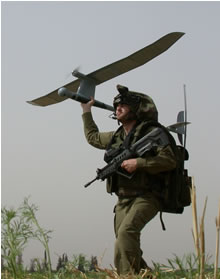
The Casper 200 miniature UAV was designed to meet an Israel defense Forces requirement for backpackable aerial surveillance, operated by a single soldier, in support of infantry operations. The 1.3 meter long MAV weighs 2.3 kg, and is constructed of composite materials. The Casper 200 is assembled in the field without any tools. The 2m' span wing is optimized for low speed, and a 1:15 glide ratio. A larger version, Caster 250 was displayed at the Paris Airshow. This MAV is equipped with an improved LEV-2 payload with daylight CCD or IIR optronics, x3 stabilization and x25 zoom.he ground component comprises an antennae group and a compact ground control station. The gimbaled payload is snapped on to the fore section. Casper 200 uses a lightweight (240gr.) payload, specially designed for small platforms, it accommodates a high resolution video camera with a x2 zoom or other sensors as required.
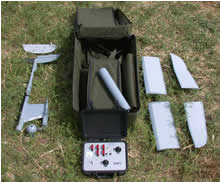
The mini UAV demonstrated excellent handling and mission performance in open area as well as in urban reconnaissance, where it's autopilot uses special obstacle avoidance algorithm. TopiVision claims the new system has superior performance compared to most of the mini UAVs of its class, due to the use of specific design, construction, particularly in the efficient aerodynamic design and telescopic, collapsible tail which effectively absorbs the landing impact. An innovative landing concept uses a wing flap to perform rapid but soft descent. Other features include improved communications, which contribute to significant power savings and cleaner aerodynamics, leaving more capacity for batteries and payload.
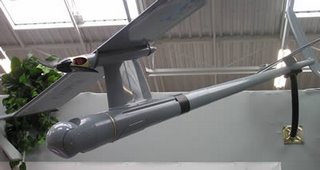
But wait on, things get much more interesting and I will continue on in the next posting.....
These are some of the new fangled uses for UAVs:-
Firstly this little number from the Israel Defence Force, in use since 2005

The Casper 200 miniature UAV was designed to meet an Israel defense Forces requirement for backpackable aerial surveillance, operated by a single soldier, in support of infantry operations. The 1.3 meter long MAV weighs 2.3 kg, and is constructed of composite materials. The Casper 200 is assembled in the field without any tools. The 2m' span wing is optimized for low speed, and a 1:15 glide ratio. A larger version, Caster 250 was displayed at the Paris Airshow. This MAV is equipped with an improved LEV-2 payload with daylight CCD or IIR optronics, x3 stabilization and x25 zoom.he ground component comprises an antennae group and a compact ground control station. The gimbaled payload is snapped on to the fore section. Casper 200 uses a lightweight (240gr.) payload, specially designed for small platforms, it accommodates a high resolution video camera with a x2 zoom or other sensors as required.

The mini UAV demonstrated excellent handling and mission performance in open area as well as in urban reconnaissance, where it's autopilot uses special obstacle avoidance algorithm. TopiVision claims the new system has superior performance compared to most of the mini UAVs of its class, due to the use of specific design, construction, particularly in the efficient aerodynamic design and telescopic, collapsible tail which effectively absorbs the landing impact. An innovative landing concept uses a wing flap to perform rapid but soft descent. Other features include improved communications, which contribute to significant power savings and cleaner aerodynamics, leaving more capacity for batteries and payload.

But wait on, things get much more interesting and I will continue on in the next posting.....
Wednesday, August 09, 2006
CEASEFIRE NOW DEMO IN LONDON
Unfortunately I was unable to attend the 100,000 strong demonstration in London last weekend but I am pleased that there are online videos of all the speeches available here. It is vital that the political pressure is kept up on the political establishment in this country to end their tacit involvement in the carnage in the Middle East and that they are forced to disassociate from the Bush Blair Israeli position and call for an unconditional ceasefire NOW. Help to make this demand a reality and get involved with your local peace group now, at http://www.bepj.org.uk.
Monday, August 07, 2006
Humanity First
 The Public Meeting against war in the Middle East "Hamanity First -End The Slaughter In The Middle East" takes place at St Peter's Civic Hall in Carmarthen on August 17th at 7.30pm. I hope that there will be a lively discussion with lot's of ideas forthcoming from the audience vis a vis various ways we can influence our leaders, especially those in New Labour.
The Public Meeting against war in the Middle East "Hamanity First -End The Slaughter In The Middle East" takes place at St Peter's Civic Hall in Carmarthen on August 17th at 7.30pm. I hope that there will be a lively discussion with lot's of ideas forthcoming from the audience vis a vis various ways we can influence our leaders, especially those in New Labour. I went to the Labour Party website yesterday and was amazed, it seems as if it is Tony Blair's own site. It pushes the speech given in LA last week as a great masterpiece of ideology but how such a great party as Labour could sink to such low levels without true discussion amongst it's members is frankly mysterious to me. Of course Blair is entitled to his own views but not to take the name of Labour in vain. Am I glad I tore up my membership card not long after the 1997 election. The man is dangerous and I fear will wreak more havoc and destruction on the world before he finally goes. I only hope he does not get anywhere near a prestige post with the United Nations, in my view he just does not deserve it.
Mazen Kerbaj - Beirut Artist

I have been reading the press and looking at the online news media and there is nothing which captures the utter despair and desperation of the bulk of the Lebanese people better than the art work of Mazen Kerbaj. Please visit his online slide show here and you will see what I mean. This is stunning anti war art which so graphically points up the complete uselessness of war. Those twin anti christs George Bush and Tony Blair see the conflict in Lebanon as a totally mechanical thing devoid of human beings. This is totally unacceptable, artists such as Mazen who keep working despite the bombing show us all that humanity is stronger than purely idealogical or religious concerns. When Blair talks about changing values in Middle East countries he points to the death of freedom and the end of dissent. With this image and all his work Mazen shows us all that we must never allow artistic expression to be diluted through fear and terror, even when we are scared shitless
Sunday, August 06, 2006
We Gotta Do What We Can
TONY BLAIR SHOWS THAT BRITAIN MEANS BUSINESS WITH STRATEGY FOR SOLVING UNEMPLOYMENT
I can't help but think about the way the imposition of the New World Order is affecting ordinary people on a daily basis. Also I know there are many people out there who are utterly sickened by the way that elected politicians can continue to claim success where there is clearly failure, such as in Iraq , profess democratic ideals yet support the detention without charge of thousands of Palestinians, prevaricate over calling for an unconditional ceasefire in Lebanon and yet continue to behave as if they hold the moral high ground whilst hundreds of men women and children die just because they happen to live where they do. Tony Blair and most of his sycophants have become part of a worrying programme aimed at bringing about a frightening reality where soldiers rarely venture out onto the battlefield to do the dirty work whilst the so called "War Fighters" sit behind their computer terminals guiding ever more sophisticated UCAVs (Unmanned Combat Ariel Vehicles) to deliver their payloads at targets designated as causing a threat to the status quo, usually resulting in widespread death of innocent civilians and untold damage to private property and community services and infrastructure. This is the modern war that is envisaged as being necessary in the fight to bring American neo-conservative so called democratic values to the world. Tony Blair, the politically bankrupt outgoing British Prime Minister still somehow expects us to invest some vestiges of moral legitimacy in him and his gung ho approach to ignoring the deafening criticism of liberal thinkers everywhere in the world. When people voted Labour in 1997 did they really think they would elect a Leader into office who takes more notice of the inner sanctums of the Pentagon than of his own Cabinet? I seriously doubt it.
So now with Iraq ravaged by what increasingly looks like civil war, and Lebanon and Gaza suffering from outrageous over the top systematic destruction aimed at completely cowing the civilian populations in all three of these countries where democratic elections have been held, what can we ordinary people in West Wales do to contribute to bringing about peace? This is the question that will be posed at a public meeting to be held in Carmarthen at St Peters Hall on 17th August 2006 doors open 7.30pm. This meeting is being organised by Bro Emlyn For Peace and Justice and all people with ideas for NVDA (non-violent direct action) are invited to attend. There will be speakers, including Rhodri Glyn Thomas (Plaid Cymru AM) and people are asked to come to this meeting with ideas.
The Campaign Against Arms Trade website is very clear about how our taxes are being used to fuel war in the Middle East.
Saturday, August 05, 2006
Hello
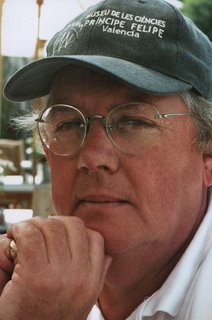
Hi Everbody,
This is my first entry on blogger.com and I hope to add commentaries on a regular basis. I start this blog as a way of communicating with mazenkerblog in Beirut. I urge all visitors here to go this site and find out about how life is carrying on despite the US backed Israeli bombings in Beirut.
I am so upset by the wars in Lebanon, Palestine, Iraq, Afghanistan etc that I want to do what I can to help bring an end to this imperialist insanity. I have been a member of Bro Emlyn For Peace and Justice since 2003 and have my own anti war website at Wild West Wales where I list occasional news and other items of interest. I will add more here later. Cheers m'dears
Subscribe to:
Posts (Atom)
